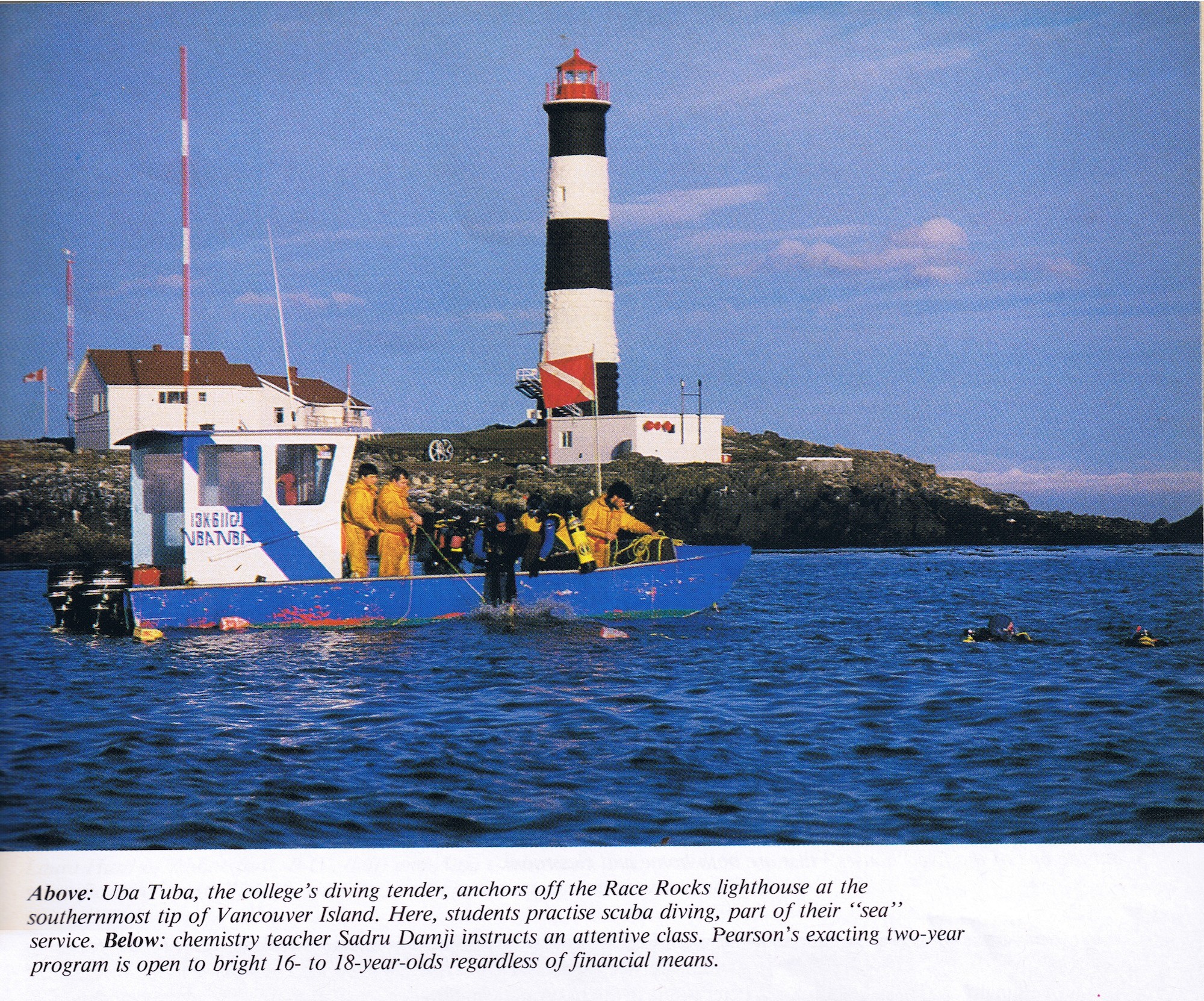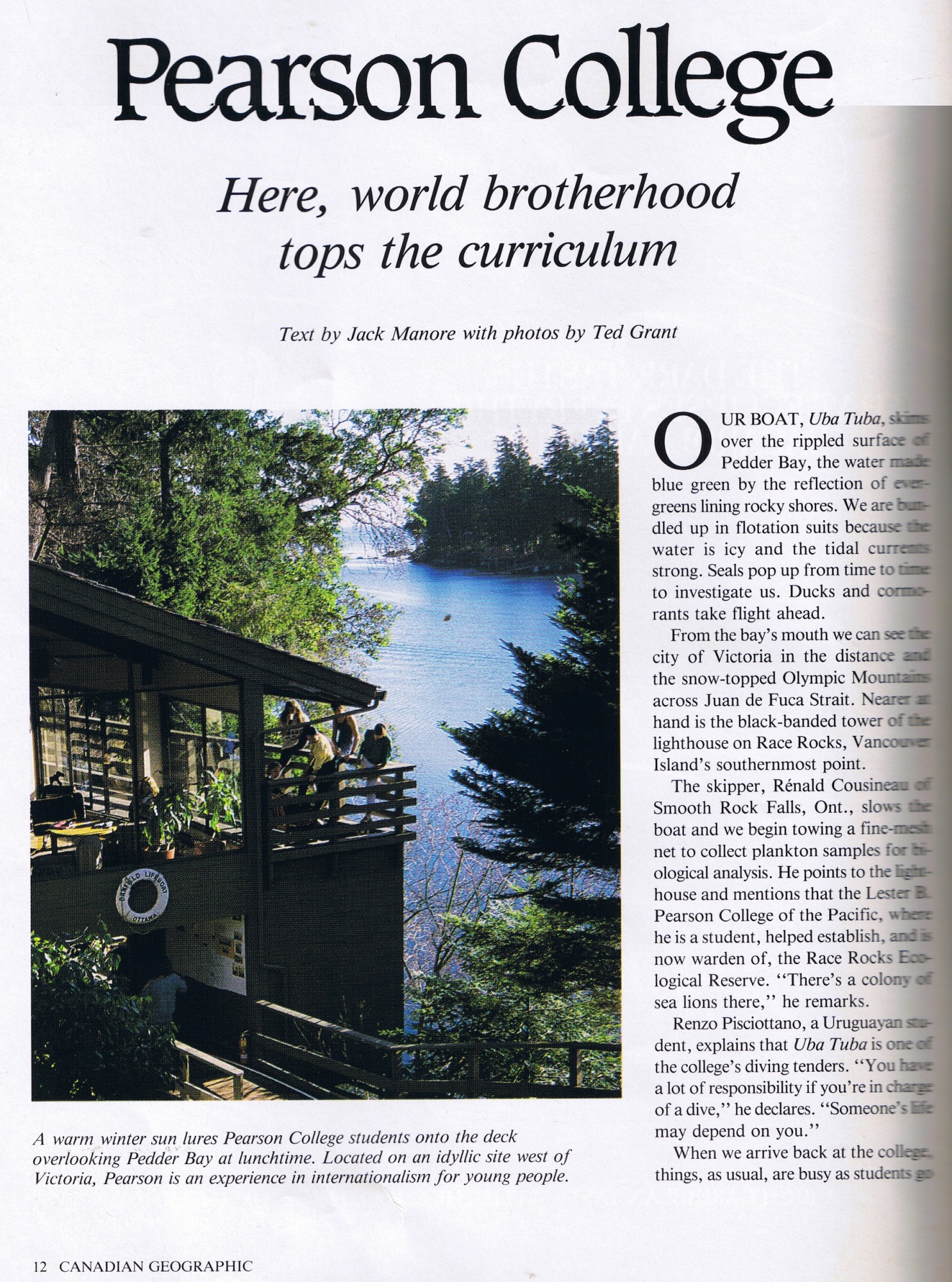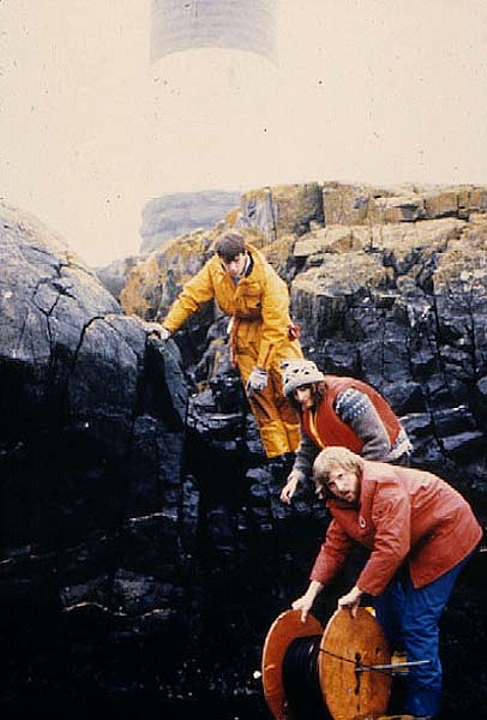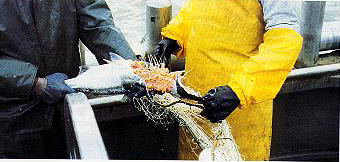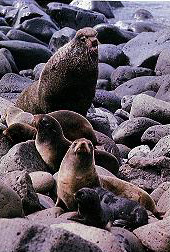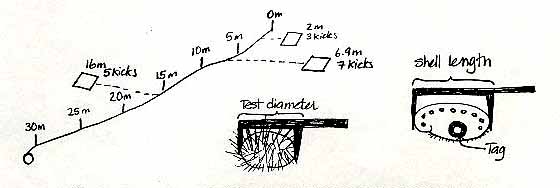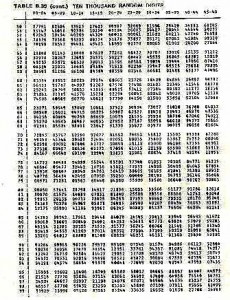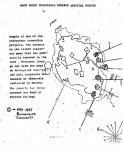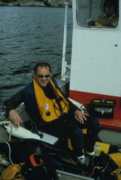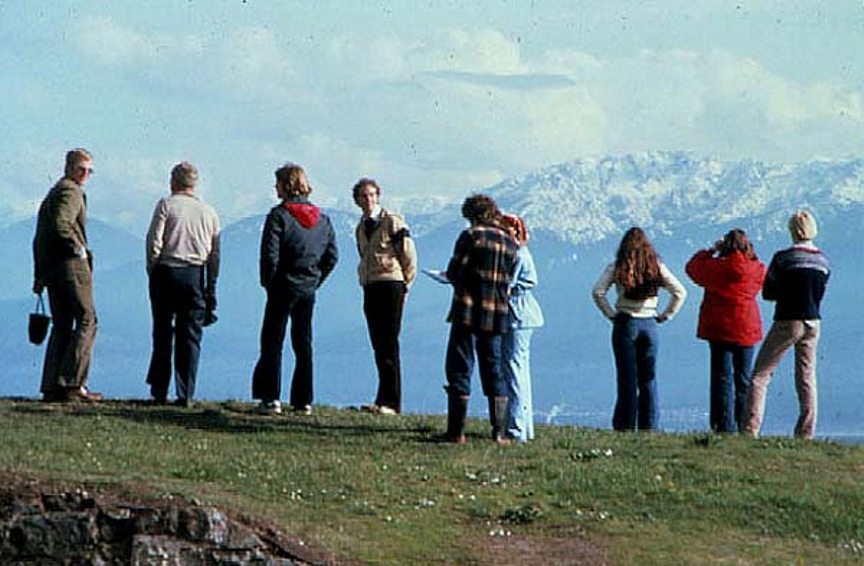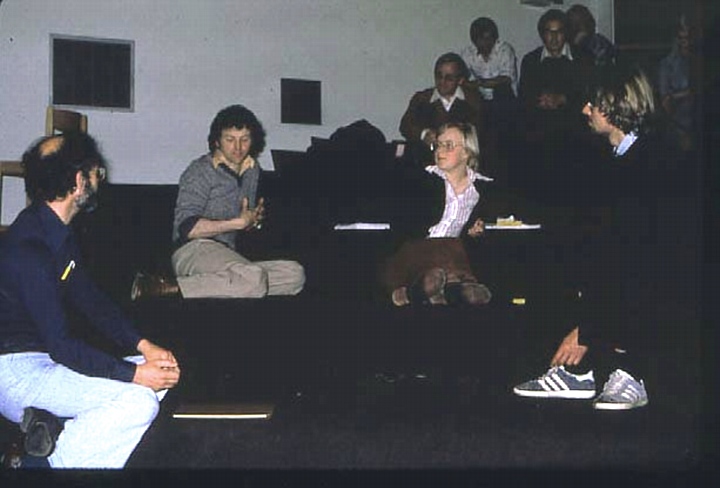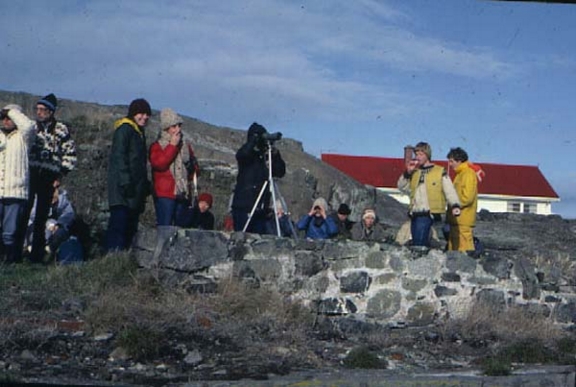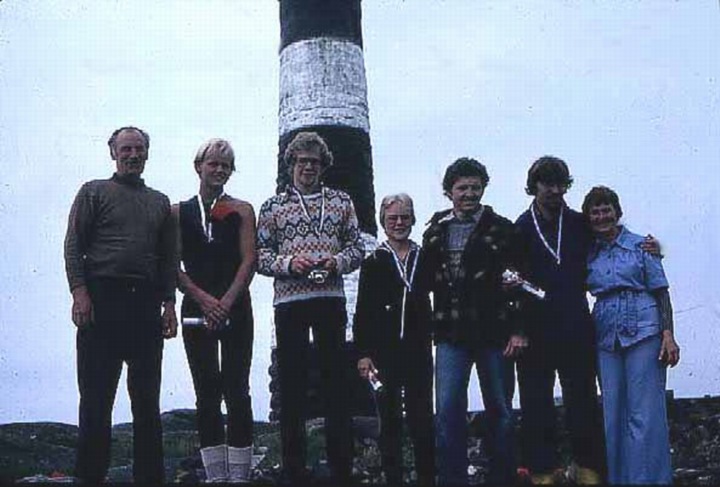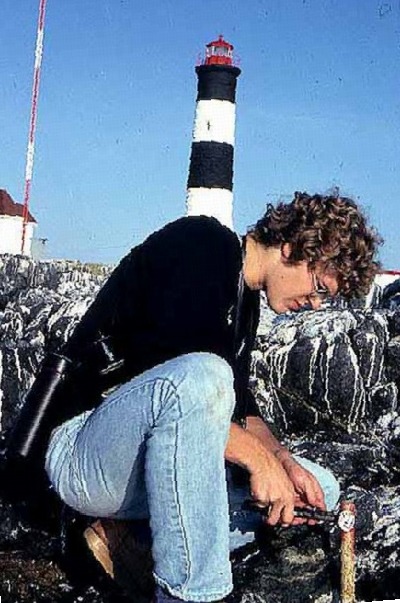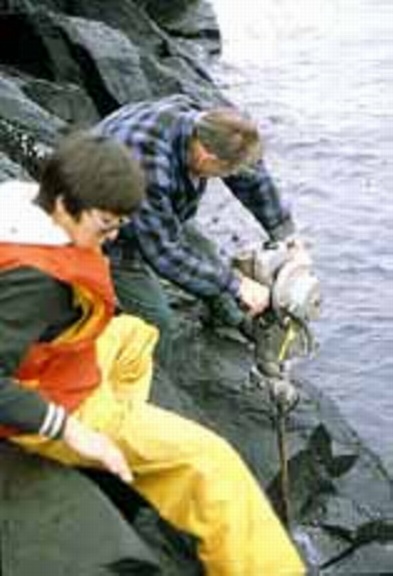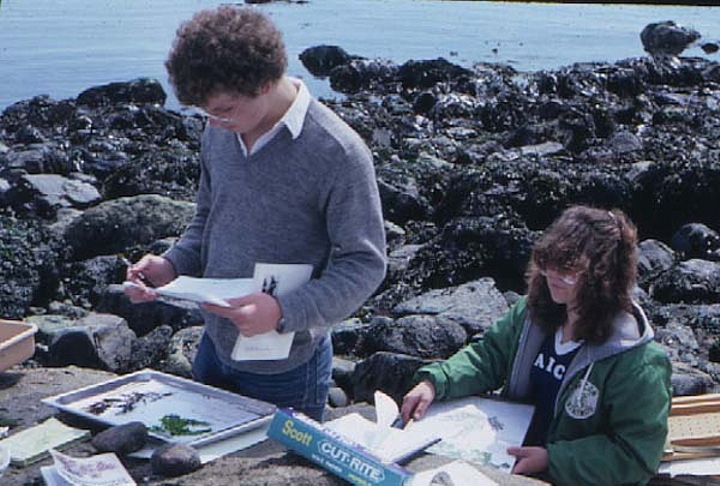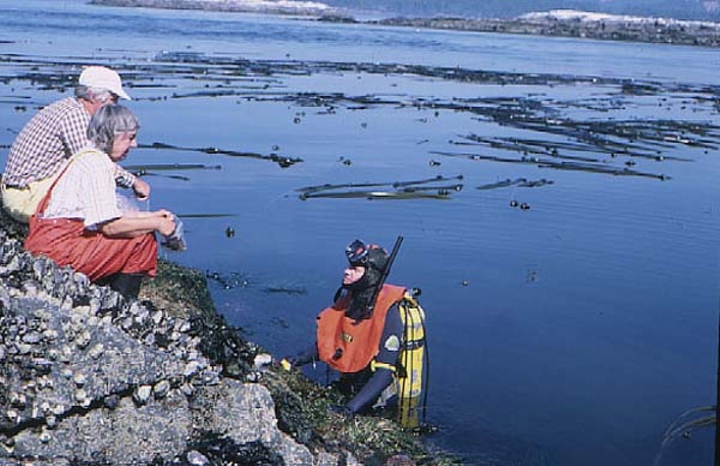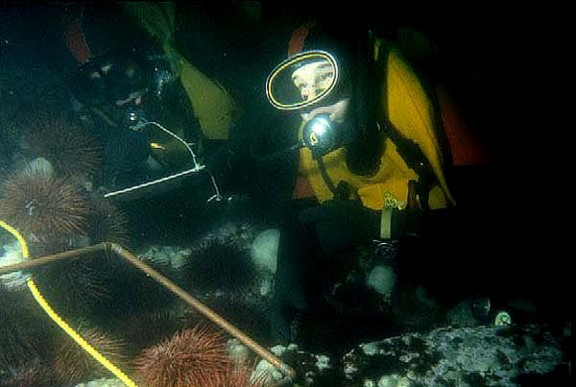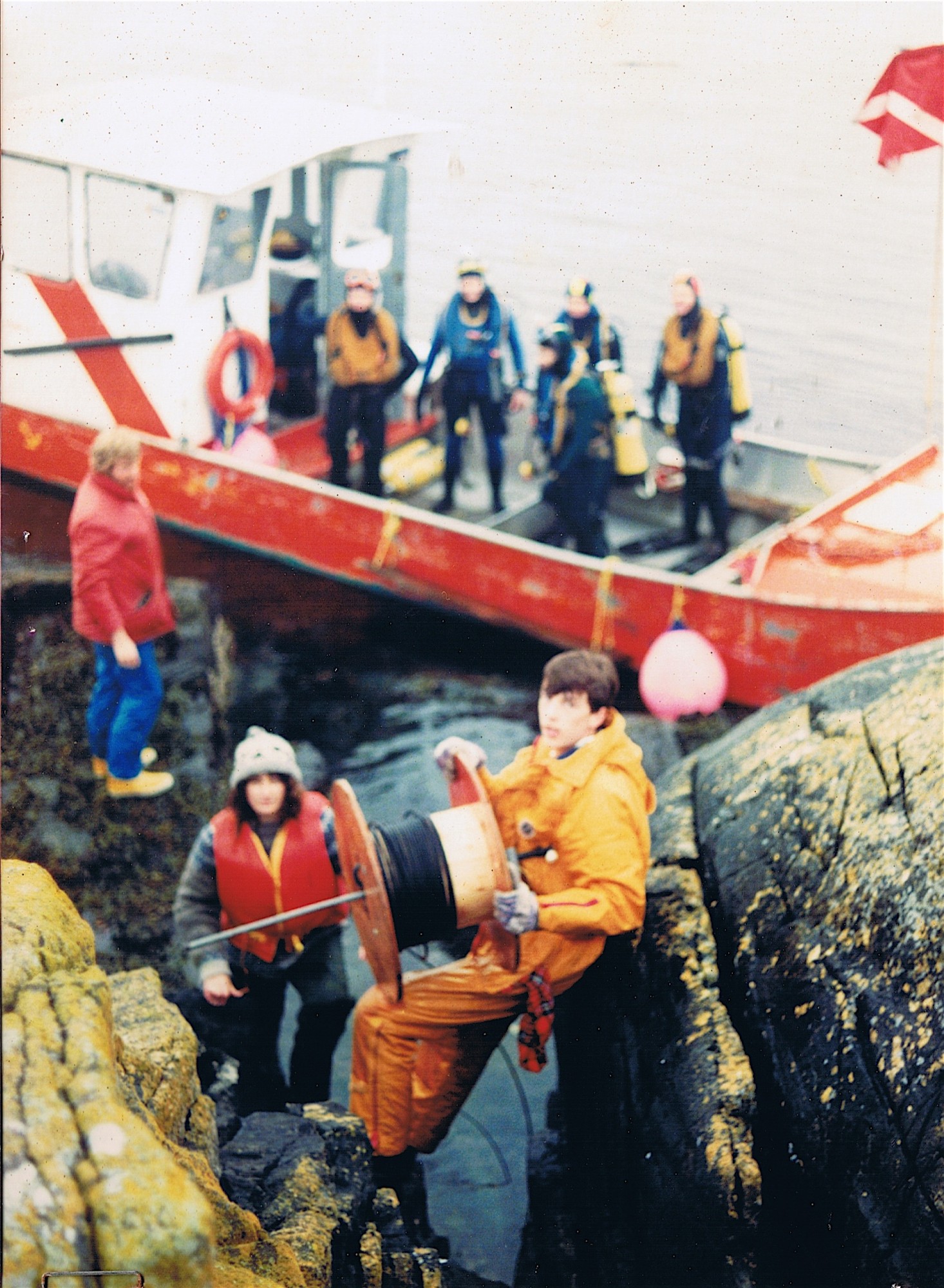This image is from the article Pearson College , Here, world brotherhood tops curriculum see below Text by jack Manor and photos by Ted Grant. Canadian Geographic, April/May 1988
Category Archives: Education
Victoria’s killer Whale Early Warning System Dec 1986.
By Robin Baird –From The Cetacean Watch Newsletter , Dec 1986.
A discussion of Victoria’s Killer whale early warning system, and the installation of the first hydrophone at Race Rocks.
Marine Mammals in British Columbia
by Peter F. Olesiuk and Michael A. Bigg (~1984)
MARINE MAMMALS IN BRITISH COLUMBIA
Peter F Olesiuk and Michael A. Bigg, (~ 1984)
Introduction
Seals and sea lions, also known as pinnipeds, are a familiar sight in coastal waters off British Columbia. These mammals lead partly a terrestrial and partly a marine existence. Their streamlined bodies, specialized flippers and insulating layer of blubber allow them to travel and forage at sea with ease. However, unlike dolphins, porpoises and whales, pinnipeds require land to bear and suckle their young and to rest.
The waters off B.C. are home to five species of pinnipeds representing two families. These are the Phocidae, or true seals, which includes the northern elephant seal and harbour seal, and the Otariidae or eared seals, which includes the northern fur seal and the Steller and California sea lions.
The true seals are characterized by the absence of external car flaps and by their short, fur-covered flippers. On land they cannot easily raise their head and shoulders and thus tend to remain prostrate. The rear flippers cannot be rotated forward, so while on land they move in a caterpillar-like fashion, rhythmically undulating their bodies with synchronized dragging strokes of the front flippers. In water, they swim by alternating side-to-side strokes of their rear flippers, while the front flippers aid in steering.
Members of the Otariidae, on the other hand, have small external ear flaps and large hairless flippers. On land the front flippers are used for body support to raise the head and shoulders. The rear flippers can be rotated under the body, which allows these animals to amble over land using both the front and rear flippers. While swimming, they use their front flippers like wings to propel and steer themselves.
Seals and sea lions in B.C. have evoked a great deal of interest over the years. At one time, they were utilized extensively for food and clothing by coastal natives. Between the early 1900s and late 1960s, they were hunted commercially and their populations regulated by predator control programs. However, increasing public sympathy toward marine mammals prompted changes in management and in 1970, harbour seals, northern elephant seals, and Steller and California sea lions were protected under the federal Fisheries Act. The northern fur seal has been protected since the early 1900s under the terms of the Interim Convention on Conservation of North Pacific Fur Seals, an international agreement involving Canada, Japan, the Soviet Union and the United States.
Since 1970, several species have become more abundant off our coast, causing concern among fishermen, who often view these animals as competitors for fish and as a source of damage to their gear and catch. It is not surprising, therefore, that many fishermen support culling programs that would maintain populations at low levels. However, this solution conflicts with the goals of many others, who believe populations should be left to reach a natural balance. Resolution of these differing perspectives presents a dilemma for fisheries managers in B.C., and in many other parts of the world.
This pamphlet provides the most recent scientific information on the status of seals and sea lions in B.C. It describes the general biology, trends in abundance and feeding habits of species that occur on the B.C. coast. The conflicts that arise with commercial and sport fisheries are also discussed.
Northern elephant seal (Mirounga angustirostris)
The Northern elephant seal is the largest species of pinniped inhabiting the Northern Hemisphere. Adult females grow to about 3 m (10 ft) in length and may weigh up to one tonne (2200 lbs). Adult males are larger and may attain a length of 5 m (16 ft) and weigh as much as 2 tonnes (4,400 lbs). Males may also be distinguished from females by their pendulous snouts. Pups weigh about 30 kg (65 lbs) at birth and are weaned in about a month, by which time they have tripled in weight. The pelage of both sexes is a uniform light brown.
Northern elephant seals are found in the northeast Pacific between California and southern Alaska. Nineteenth century sealers operating off the coasts of California and Mexico hunted these seals to the brink of extinction, and by the turn of the century the species had been reduced to a few hundred individuals. Since then the population has made a remarkable recovery to near historic levels of about 100,000 and is continuing to increase.
During December to March, most northern elephant seals congregate on islands and beaches off California and Mexico to bear their young and mate. By the end of March the pups have been weaned and all animals begin to disperse from the rookeries to forage on the continental slope. Pups and adult males tend to move north along the coast, occasionally as far as Alaska. Relatively few reach B.C. Adults rarely haul out in B.C. and are usually seen resting vertically in the water with their massive head and neck extending above the water like a large log. However, weaned pups, which weigh about 70 kg (150 lbs.), occasionally come ashore to rest. Because of behavior, they are often thought to be sick.
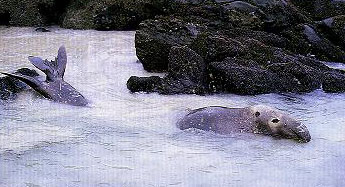 Northern elephant seals are capable of diving for up to 45 minutes and to a depth of 806 m (2,600 ft). They prey mainly on ratfish, sharks, cusk eels and squid. This seal has not been a problem for fishermen in B.C.
Northern elephant seals are capable of diving for up to 45 minutes and to a depth of 806 m (2,600 ft). They prey mainly on ratfish, sharks, cusk eels and squid. This seal has not been a problem for fishermen in B.C.
(PHOTOS) Northern elephant seals have likely been the source of more than one sea monster sighting. Photos courtesy of Kenneth Balcomb, Center for Whale Research, Friday Harbour, Washington.
Harbour seal Phoca vitulina
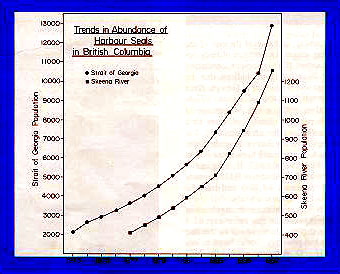 The harbour seal is a relatively small phocid. Males and females are similar in size and as adults attain a length of 1.2-1.6 m (4-5 ft) and usually weigh 60-80 kg (130-180 lbs). Pups weigh about 10 kg (22 lbs) at birth and double their weight during a 4-6 week suckling period. Males live up to 20 years, while the life span of females extends to 30 years. The pelage varies in color from nearly black with light spots to nearly white with dark spots.
The harbour seal is a relatively small phocid. Males and females are similar in size and as adults attain a length of 1.2-1.6 m (4-5 ft) and usually weigh 60-80 kg (130-180 lbs). Pups weigh about 10 kg (22 lbs) at birth and double their weight during a 4-6 week suckling period. Males live up to 20 years, while the life span of females extends to 30 years. The pelage varies in color from nearly black with light spots to nearly white with dark spots.
Harbour seals occur in most temperate coastal areas of the North Atlantic and North Pacific Oceans, and also enter navigable rivers and lakes. Although no precise figures are available, the northeast Pacific population is estimated to number at least 350,000.
These seals are typically seen in small groups resting on tidal reefs, boulders, and sandbars, but they can sleep under-water on the ocean bottom if no suitable haulout site is available. The population is traditional in the particular sites utilized as haulouts. There is little social organization in these colonies. Unlike many other pinnipeds, harbour seals do not congregate on rookeries but breed throughout most of their range. The birth season lasts about 2 months and varies from February-March to August-September, depending on location. In southem B.C., births occur in July-August and during May-June in northern B.C. Pups are usually born on tidal reefs or sandbars and begin to swim immediately. Although local movements associated with breeding and feeding may occur, harbour seals are otherwise non-migratory.
The abundance of harbour seals has been monitored in Georgia Strait since the mid 1960s. Counts are usually conducted from small aircraft at times when most of the population is hauled out. In Georgia Strait about 90% of the animals haul out on low tides, on calm days, in the morning, and toward the end of the pupping season.
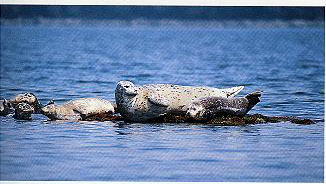 The pelage of harbour seals varies considerably in color and pattern. Harbour seal populations in B. C have been increasing in all areas surveyed by DFO. The increases, believed to be occurring province-wide, represent the recovery of populations that had been depleted by bounties and hunting.
The pelage of harbour seals varies considerably in color and pattern. Harbour seal populations in B. C have been increasing in all areas surveyed by DFO. The increases, believed to be occurring province-wide, represent the recovery of populations that had been depleted by bounties and hunting.
Department of Fisheries and Oceans (DFO) surveys conducted under these conditions indicate that the harbour seal population in Georgia Strait has grown from about 2,100 in 1973 to 12,500 in 1987, a rate of increase of 12.4% per year. Similar increases have occured in all other areas censused. For example, in the lower Skeena River counts have increased from about 400 in 1977 to 1,250 in 1987. It is estimated that the total population in B.C. currently numbers about 65,000 and may be approaching historical levels.
This recent increase in numbers in B.C. represents the recovery of a depleted population, which in the late1960s had probably been reduced to less than 15,000. A bounty offered by DFO for each seal killed between 1913 and 1964 reduced populations to about half historic levels. Harbour seals were also intensively hunted for their pelts between 1962 and 1969. The population could not withstand this additional hunting and declined sharply during the mid 1960s.
Researchers at the Pacific Biological Station in Nanaimo recently began examining the impact of the growing harbour seal population on fisheries. Data are presently being collected on diet, seasonal movements and abundance in conflict areas to establish the extent to which seals interfere with fishing activities and their impact on important fish stocks, such as salmon and herring.
One of the main topics now being studied is the amount of salmon consumed by harbour seals. The amount of food eaten by a seal depends on its size and sex, the season and the caloric content of the prey. On average, harbour seals consume about 1.8-3.2 kg (4-7 lbs) of fish daily. At present not enough is known about the diet of harbour seals to accurately estimate the amount of salmon eaten. Preliminary findings indicate that in most localities, harbour seals prey mainly on a wide variety of small fishes that occur in shallow water around reefs. These include sculpins, small flatfishes and rockfishes, greenlings, smelts and perches. During winter their diet consists mainly of hake and, to a lesser degree, herring. However, salmon may constitute an important part of the diet in some rivers and estuaries while salmon are spawning.Harbour seals also create problems for fishermen by removing salmon from gear. Gillnetters and sport fishermen experience the greatest losses.
Harbour seals create problems for commercial fishermen by removing and damaging salmon in gillnets. Harbour seals also take salmon from the lines of recreational fishermen.
Harbour seals typically occur in small groups on tidal reefs (above) but large herds occur at the mouths of major rivers (left).
Northern fur seal Callorhinus ursinus
Adult male northern fur seals are much larger than females, attaining a length of 1. 9m (6 ft) and weight of 200 kg (450 lbs) compared to 1.3 m (4 ft) and 35 kg (80 lbs) for females. Pups weigh 4.5-5.5 kg (10-12 lbs) at birth and are nursed for 4 months, during which time they increase 2-3 fold in weight. Females can live to about 25 years whereas males rarely live longer than 15 years. The pelage of both sexes is greyish brown and includes a dense layer of underfur.
The northern fur seal is found in off-shore waters throughout the North Pacific Ocean from the latitudes of southern California and southern Japan into the Bering and Okhotsk Seas. The eastern North Pacific stock numbers about 900,000 seals. This stock has declined in recent years, for reasons which are not clear. One likely cause is increased mortality of juveniles many of which drown each year from entanglement in plastic debris, such as discarded nets and packing bands. Two other stocks, with a combined population size of about 400,000 seals, are found off the Asian coast.
Fur seals inhabiting the eastern North Pacific congregate on the Pribilof Islands in the Bering Sea during June to October to give birth and mate. When animals leave the rookeries in November they disperse widely throughout the eastern North Pacific, but tend to be most concentrated over the continental shelf. Most adult females and a few juveniles migrate to California and pass south through B.C. waters in early winter and north in late spring. Some individuals remain off the B.C. coast during winter and spring, but few come closer than 10 miles to shore. Most adult males remain in the Gulf of Alaska during the non-breeding season.
The northern fur seal has been hunted commercially for its fur since the late 1700s. Most seals were taken on rookeries, although many were also taken at sea during the late 1800s and early 1900s. Victoria was an important port for these pelagic sealing operations. For most of this century only young males, aged 3-5 years, have been harvested on the rookeries. Under the terms of the Interim.
Above: Northern fur seal bull (rear), cows (middle), and pups (front) during the breeding season. In many species of pinnipeds males are larger than females, probably because of their polygamous breeding customs.
Northem ,fur seals inhabiting the northeast Pacific gather on the Pribilof Islands in the Bering Sea each summer to give birth and mate.
Convention on Conservation of North Pacific Fur Seals, Canada received 15 per cent of the skins from harvests of the Pribilof Islands and Asian rookeries. However, the Convention expired in 1984 and only subsistence sealing is now permitted on the Pribilof Islands.
As part of Canada’s obligations under the Interim Convention, the reproductive biology, diet, and food requirements of this species were studied extensively at the Pacific Biological Station during 1958-80. Northern fur seals feed mainly on small schooling fishes. In waters off B.C., 20 % of the diet is salmon and 43 % herring. The amount of food consumed varies with season, but adult females typically eat about 2.5 kg (5.5 lbs) of prey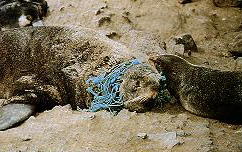 daily. However, the total amount of fish consumed off B.C. cannot be precisely determined because of the difficulty in estimating the number of seals wintering off our coast. Few fishermen in B.C. consider fur seals to be a serious problem.
daily. However, the total amount of fish consumed off B.C. cannot be precisely determined because of the difficulty in estimating the number of seals wintering off our coast. Few fishermen in B.C. consider fur seals to be a serious problem.
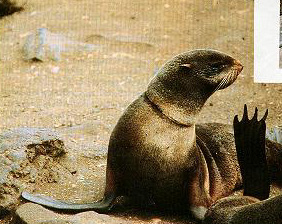 Entanglement of fur seals in fishing debris (above) and packing bands (below) may be responsible for recent population declines.
Entanglement of fur seals in fishing debris (above) and packing bands (below) may be responsible for recent population declines.
Steller sea lion Eumetopias jubatus
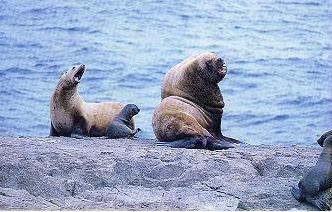 Steller sea lions are the largest member of the Otariidae. Adult males reach 3 m (10 ft) in length and weigh 450-1,000 kg (1,000-2,200 lbs) whereas the smaller females are 2.4 m (8 ft) long and weigh 180-230 kg (400 – 500 lbs). Pups weigh about 20 kg (45 lbs) at birth and may be nursed for more than a year. The life span of males is about 20 years and that of females about 30 years. The pelage consists mainly of coarse guard hairs and is usually tan in color.
Steller sea lions are the largest member of the Otariidae. Adult males reach 3 m (10 ft) in length and weigh 450-1,000 kg (1,000-2,200 lbs) whereas the smaller females are 2.4 m (8 ft) long and weigh 180-230 kg (400 – 500 lbs). Pups weigh about 20 kg (45 lbs) at birth and may be nursed for more than a year. The life span of males is about 20 years and that of females about 30 years. The pelage consists mainly of coarse guard hairs and is usually tan in color.
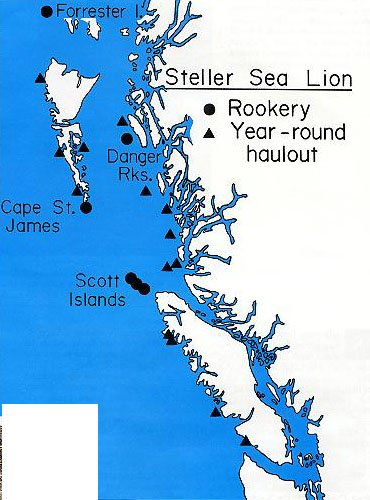 The Steller sea lion occurs along the coastal rim of the North Pacific Ocean, from California to the Bering Sea and Kurile Islands. The species tends to remain within a few miles of shore, but is occasionally seen as far as 130 km (80 miles) offshore. Although juveniles have been found up to 1,500 km (900 miles) from their place of birth, adults are largely non-migratory. The total population numbers about 200,000 with most occurring in the Gulf of Alaska. However, populations in Alaska have recently been declining inexplicably, and are now only half the size they were in the 1950s.
The Steller sea lion occurs along the coastal rim of the North Pacific Ocean, from California to the Bering Sea and Kurile Islands. The species tends to remain within a few miles of shore, but is occasionally seen as far as 130 km (80 miles) offshore. Although juveniles have been found up to 1,500 km (900 miles) from their place of birth, adults are largely non-migratory. The total population numbers about 200,000 with most occurring in the Gulf of Alaska. However, populations in Alaska have recently been declining inexplicably, and are now only half the size they were in the 1950s.
During June and July most of the population gathers on rookeries to breed. In B.C., rookeries are situated at Cape St. James, North Danger Rocks and on the Scott Islands. Animals tend to return to the rookery on which they were born. Some adults and juveniles are also found on sites known as year-round haulouts during the breeding season. In late summer and fall individuals on rookeries disperse locally along the coast to numerous wintering sites.
Aerial censuses conducted during the breeding season indicate that the population in B.C. is currently about 7,000 (including 1,100 pups) and has changed little since the mid 1960s. The current population represents only about one-third the number present at the turn of the century. The reason for the decline was extensive kills between 1912 and 1968. During that time, DFO staff made annual trips to rookeries and haulouts to kill sea lions for predator control. Adults were also commercially harvested on rookeries for mink food.
Why the population in B.C. has not recovered appreciably since it was protected in 1970 is not clear. Competition with Steller sea lions breeding at Foffester Island in Alaska, a few km north of the B.C. border, may be a factor. The Forrester Island stock increased from a few hundred animals in the 1920s to about 6,000 by the 1970s. In fact, almost twice as many pups are now born on Forrester Island as on all rookeries in B.C. Thus, the combined breeding populations for B.C. and southeast Alaska may now be close to historic levels.
Fishermen have long been concerned over the impact of Steller sea lions on commercially valuable fish stocks. On average, females consume about 5-10 kg (11-22 lbs) and males 10-20 kg (22-45 lbs) daily. During the breeding season, Steller sea lions feed predominantly on octopus and a variety of fish, mainly rockfish. During the non-breeding season they prey mainly upon schooling fishes such as herring, hake, pollock, dogfish, and salmon. Overall, salmon constitutes only a few per cent of their diet.
Steller sea lions also create problems for fishermen by interfering with fishing activities. Some individuals apparently learn to follow commerical trollers and remove salmon from their lines. Sea lions also occasionally pilfer salmon and herring from gillnets and may inflict considerable damage to gear in the process.
Steller sea lion bull (right), pup (middle), and cow (left) showing the difference in size between sexes. Because males must staunchly defend breeding territories, they fast and may lose 200 kg (450 lbs.) during the 2 month breeding season.
Province-wide censuses are usually conducted when animals are congregated during the breeding season. Shown here is a portion of the Forrester Island rookery just north of B. C. which has grown dramatically in size over the last 50 years.
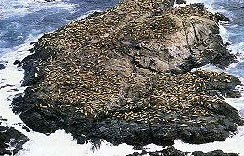 While the remaining animals are relegated to year-round hautouts . During the non-breeding season animals disperse to numerous wintering sites along the coast.
While the remaining animals are relegated to year-round hautouts . During the non-breeding season animals disperse to numerous wintering sites along the coast.
California sea lion Zalophus californianus
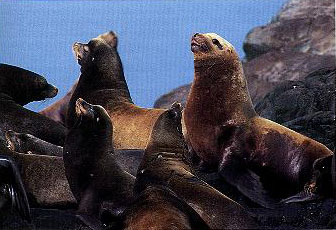 The California sea lion is smaller and darker than the Steller sea lion. Adult males are about 2.25 meters (6.5-8 ft) long and weigh 200 – 400 kg (450-900 lbs) whereas females are 1.4-1.7 meters (4.5-5.5 ft) and 70 – 110 kg (150-250 lbs). Pups weigh about 8 kg (18 lbs) at birth and may nurse for up to a year. The pelage is usually dark brown and appears almost black when wet. Mature males develop a patch of fight colored fur on the crest of their head.
The California sea lion is smaller and darker than the Steller sea lion. Adult males are about 2.25 meters (6.5-8 ft) long and weigh 200 – 400 kg (450-900 lbs) whereas females are 1.4-1.7 meters (4.5-5.5 ft) and 70 – 110 kg (150-250 lbs). Pups weigh about 8 kg (18 lbs) at birth and may nurse for up to a year. The pelage is usually dark brown and appears almost black when wet. Mature males develop a patch of fight colored fur on the crest of their head.
There are three populations of California sea lions: the largest population numbers about 120,000 and breeds off the coasts of California and Mexico; another population of 20,000-50,000 breeds on the Galapogos Islands; and a small population, perhaps now extinct, was known to breed off Japan. Large kills off California and Mexico during the 1800s depleted that population and reduced its range. However, the population has been increasing since the turn of the century and may now be approaching historic levels.
Only adult and sub-adult male California sea lions occur in B.C., mainly during winter months. Between May and August most animals congregate on rookeries off the coast of California and Mexico to pup and mate. At the end of the breeding season animals leave the rockeries. Females and juveniles remain in California and Mexico during the nonbreeding season. Adult and sub-adult males tend to travel north, venturing as far north as central Vancouver Island. They arrive in B.C. in September-October and depart in April-May.
The number of California sea lions wintering off southern Vancouver Island has grown dramatically in recent years. Prior to the 1960s this species was rarely seen here, but by the early 1970s about 500 were present. Numbers increased to about 1,500 by the early 1980s, peaking at 4,500 in 1984. Numbers have since stabilized at about 3,000. The expansion of California sea lions into B.C. is probably a result of the recovery of the breeding population off California. The warm El NiÒo currents in the early 1980s and the recovery of local herring stocks may also have attracted more animals to B.C.
California sea lions wintering off southern Vancouver Island mix extensively with Steller sea lions. The impact on fisheries here is thus being examined for both species combined. The number of Steller sea lions wintering off southern Vancouver Island has increased slightly from about 700 in the early 1970s to about 1,200 currently. It is unclear whether this increase represents a redistribution of Steller sea lions that breed on local rookeries or whether Steller sea lions are being displaced northward from California and Oregon by the expanding population of California sea lions.
The increase in the number of sea lions wintering off southern Vancouver Island raised many concerns over their impact on local salmon and herring fisheries. Between 1982 and 1985 DFO collected extensive data on the abundance, distribution and feeding habits of these animals. Preliminary analysis of these data indicate that the wintering population feeds mainly on schooling fishes such as herring, hake, pollock and dogfish. Herring make up about 35 per cent of the diet and approximately 2,400 tonnes are consumed annually. This represents about 15 per cent of the average annual roe herring harvest off Vancouver Island in recent years. Salmon comprise about 10 per cent of the diet and 600 tonnes are consumed annually, representing less than I per cent of the commercial salmon landings in B.C.
Sea lions wintering in B.C. are also a problem during the short herring fishery. Animals may swim through the fragile gillnets, tearing large holes in them, and occasionally get into purse seines.
Male California sea lions (left) can be distinguished from a male Steller sea lion (far right) by their darker pelage, smaller size, light fur on the crest of their head, and honking bark as opposed to the Steller sea lion’s deep growl.
In areas where no suitable haulout site is available, sea lions may rest in rafts. The flippers are often held out of the water, perhaps to minimize heat loss.
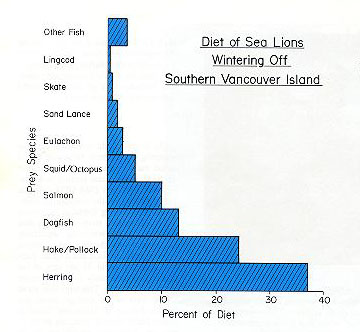
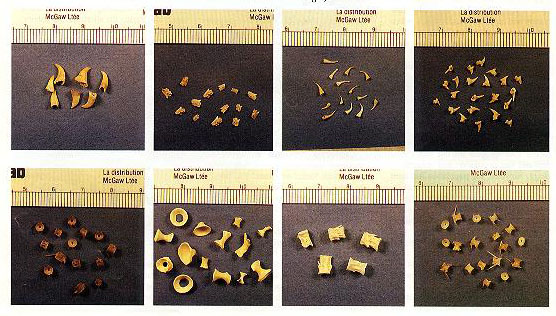 Recent studies into the feeding habits of sea lions wintering off southern Vancouver Island indicate that they prey mainly upon mid-water schooling fishes.
Recent studies into the feeding habits of sea lions wintering off southern Vancouver Island indicate that they prey mainly upon mid-water schooling fishes.
The diet of seals and sea lions can be evaluated by examining undigested remains in scats. Shown here are salmon, dogfish, hake, and skate teeth (top row, left to right) and salmon, dogfish, hake, and herring vertebrae (bottom row, left to right).
Management Policy
The Department of Fisheries and Oceans is responsible for the management and conservation of marine resources including seals and sea lions. The goals of management are to conserve these resources and to utilize them in the best interest of all Canadians. Management policy must balance the diverse and sometimes conflicting interests of Canadians.
For the first half of this century, management of seals and sea lions in B.C. focused on maintaining populations at relatively low levels by culling and hunting for meat and pelts. This kept competition for fish and interference with fishing activities at a low level. In the 1960s a greater interest developed in the preservation of natural resources and controversy arose around the hunting of whales and seals. Strong opposition to the killing of marine mammals emerged.
In 1970 regulations made under the Fisheries Act were amended such that the killing of sea lions, harbour seals and northern elephant seals required a license from the Minister of Fisheries. Since virtually no licenses were issued, this allowed some species, like the harbour seal and California sea lion, to become more abundant in B.C. The presence of more seals and sea lions in B.C. means that there are more animals for tourists to view in their natural habitat and that visibly reassures people that they are not endangered. On the other hand, the increases have raised concern among fishermen and fisheries managers over the impact on fishing gear, catches and on fish stocks, particularly salmon. The conflict of interests makes the management of seals and sea lions considerably more complex than in the past.
Appropriate balancing of the interests depends on information on the actual impact of seals and sea lions on fish stocks and the extent of damage to gear and catch. Research on seals and sea lions in B.C. being conducted by the Department of Fisheries and Oceans is providing this biological information to permit improved assessment of the social and economic implications of various management policies. The assessment process will also require input from the fishing industry, recreational fishing interests, conservation groups and other interested parties.
Suggested Reading
Haley, D. (ed.) 1976. Marine Mammals, 2nd edition. Pacific Search Press, Seattle. 256p.
Pike, G.C. and I.B. MacAskie. 1969. Marine Mammals of British Columbia. Fisheries Research Board of Canada. Bulletin 171 54p.
Ridgway, S.H. and R.J. Harrison (eds.) 1981. Handbook of Marine Mammals. Vol. 1. The walrus, sea lions, fur seals and sea otter. Academic Press, London. 235p.
Ridgway, S.H. and R.J. Harrison (eds.) 1981. Handbook of Marine Mammals. Vol. 2. Seals. Academic Press, London. 359p.
Marine Science Field exam at Race Rocks
Today Garry took his first year marine science class to Race Rocks for their final exam. Six stations were set up where students rotated through, doing measurements, making observations and solving various problems in the intertidal. Only problem was the kelp flies which are a real bother when trying to write answers in a field study.
Social organization of mammal-eating killer whales: group stability and dispersal patterns
Race Rocks Long-Term Monitoring Program
What is the purpose of long-term monitoring projects?
Long-term monitoring projects are often used to follow changes in community composition or structure that occur over time. In this case you will be looking at natural changes in marine algae and invertebrate populations with respect to both long and short-term changes in water temperature.
How will this project be carried out?
You will be helping to establish the study sites which ultimately Pearson college will monitor two to three times a year. At least four of these sites will be at Race Rocks, others will be established at other sites that Pearson College divers visit regularly.
What will this involve?
Over the next three months we will be putting the permanently marked transects in. Once we have established all of the transects we will start to sample them. On each permanently marked transect Coast-watch divers will use randomly placed quadrats to estimate the abundance of selected invertebrates and algae.
In the lab the data will be entered and analyzed. These data should show how the abundance of many of many marine plants and animals change over time.
We will also be installing an underwater thermograph. This small instrument will record water temperature at predetermined intervals. Several times a year Pearson college divers will retrieve the instrument and down-load the data onto a computer. Changes in the composition of the marine community can then be examined with respect to mean temperatures, extreme temperatures and so on.
In addition to counting the abundance of marine invertebrates and algae, we will be tagging abalone, in an attempt to follow growth and mortality of individual abalone. We will also be measuring urchins which will allow us to follow changes in the population structure over time.
What will you need to know to sample these sites?
There are a number of plant and invertebrate species that you will need to be able to identify before we can sample the sites. You will also need to know how to sample using a quadrat, tag abalone and use vernier callipers… not exactly difficult stuff.
You will also need to know how to enter and analyze the data you collect. We will set things up so that this is straightforward. At the end of the school term you will be able to plot the mean abundance of the organisms we sample at all of our permanent transects. In subsequent years other Pearson College divers will continue to sample these sites.
Some species you will need to know
Invertebrates
Phylum Echinodermata
Red urchin – Strongylocentrotus franciscanus
This is the most abundant of the urchins, it is unmistakable, being big and red. We will count the number of red urchins in each quadrat, as well as measuring the test diameter of the urchins. This will be done with vernier callipers. By measuring the size of the urchin tests we will be able to trace the settlement of new “recruits” and follow their growth.
Green urchin – S. droebachiensis
This is the smaller green urchin that is quite common in sheltered areas. We will count green urchins, but not measure them, unless they are very abundant at any of our sites.
Purple urchin – S. purpuratus
A small purple urchin that is generally found in the very shallow subtidal, and sometimes in the intertidal. If it occurs on any of our sites we will count them only.
Green urchins – S. droebachiensis
A small green urchin that is generally found in more sheltered waters, we will probably not encounter too many green urchins.
Giant sea cucumber – Parastichopus californicus
A large browny red sea cucumber, These are generally found in sheltered areas, or in water depths of greater than 10m. They are found on both hard and soft-bottoms.
Orange sea cucumber – Cucumaria miniata
This cucumber has a browny red body and bright orange tentacles. It is found in crevices wifli its tentacles extending beyond the crevice.
Sunflower star – Pycnopodia helianthoides
The largest of the sea stars, it can be up to lm in diameter, it comes in a variety of colours, usually orangy brown. It has up to 24 legs.
Leather star – Dermasterias imbricata
The leather star has a red back with greeny makings. It derives its name from its ieather-like texture. If you smell it (no not underwater) it has a gunpowder/garlic smell.
Beach star – Pisaster ochraceus
Yellow or purple, generally intertidal, but also found subtidally at some locations .
Painted star – Orthasterias khoeleri
Orange pink and purple, a very attractive sea star that occurs subtidally on rocky bottoms.
Blood star – Henticia spp.
This bright red, star is very common on both rocky and soft-bottomed areas.
Basket star – Gorganocephalus eucnemis
This species usually occurs in deep water, but Race Rocks is unique in having this species in shallow subtidal water.
Phylum Mollusca
Abalone – Haliotois kamtschatkana
The pinto abalone occurs from the lower intertidal to depths of about 10m. We will count, measure and tag all of the abalone we encounter. When tagged abalone are re-encountered they will be re-measured to follow growth in abalone.
Red turban snail – Astraea gibbersoa
A medium-sized snail that is very common on coralline algae. It has a hard operculum, and a shell that becomes covered with coralline algae.
Gumboot chiton – Cryptochiton stelleri
‘Ite largest chiton on our coast. You cannot see the 8 shell or plates that make up the gumboot chiton’s shell, they are hidden beneath the pinky brown tissue on the dorsal surface.
Cnidaria
Plumose anenome – Metridum senile
A very abundant bright white anenome, that does particularly well in high current areas. We will count anemones as we encounter them.
There will be other invertebrates added to this list once we determine which species are representative of the areas we are sampling.
Brown Algae
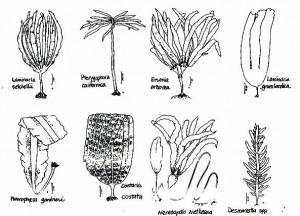 Kelps – Laminariales
Kelps – Laminariales
Bull kelp – Nereocystis luetkeana
Bull kelp is an annual species, it grows rapidly in areas that are highly disturbed. Bull kelp forms a floating canopy, it is very common at Race Rocks.
Tree kelp – Ptrerygophora californica
Tree kelp looks very much like a tree. It is a perennial species that lives in excess of 17 years. Pterygophora can be aged by cutting it down and counting the rings in its stalk or stipe. We will be tagging tree kelp on one of the transects at Race Rocks this will allow us to look at the persistence of tree kelp
Eisenia arborea
Eisenia looks very much Pterygophora, except that it has blades which are serrated at the edges, and the blades grow in two “bunches” at the top of the plant.
Laminafia setcheIlii
Laminaria groenlandica
These two species do not have a common name. Laminaria setchellii found in similar areas to Pterygophora, except that Laminaria setchellii is generally found in slightly more exposed areas.
Laminaria groenlandica is found in more sheltered areas. It looks quite different than Laminaria setchellii, since the two species are found in different areas you should have no trouble sorting them out.
Costaria costata
Costaria is really distinctive, it has three ribs on one side and two ribs on the other. It is generally an annual species but frequently manages to overwinter.
Acid weed – Desmarestia spp.
Acid weed is an annual species, which has a very “weedy” life history, it grows in highly disturbed areas, and is one of the first species to grow in areas that have been disturbed. It is very hard to count, because it forms a blanket over the sea floor, to count it you have to go down to the holdfast.
Pleurophycus gardneri
This species is generally found in very shallow areas in wave-washed areas. It is very distinctive.
There will be other species of algae that we add to our list.
SAMPLING
To sample the invertebrates at each of the permanently marked sites we will be using quadrats. Most of you will have done quadrat sampling before.
We will be using a random – sampling method, in which quadrats are placed randomly along / or near the transect line, and the selected invertebrates and algae in each quadrat will be counted. From these data we will calculate the mean (average) abundance as well as the variation in abundance that occurs at each site. These data will plotted in graphs which compare the abundance of each species over time, and with respect to changes in temperature.
We will go over the sampling methods prior to starting the project. All data will be recorded on data sheets pre-printed on underwater paper. An example of the type of data sheet we will be using is attached.
Long-term sampling programmes are often used to follow changes in the abundance of plants and animals over time. We will be looking at changes in the abundance of algae and invertebrates at Race Rocks. These changes will be examined with respect to changes in water temperature. The sampling method we will be using is called a stratified-random sample.
What is stratified random sampling?
In a stratified random sample we will sample the sea floor in a random manner, that is there will be no predetermined pattern to the sampling programme. The samples will be stratified because we will make sure that three depths are represented equally in our random samples.
What will we need?
Each dive pair will need
– a 30m tape measure
– a 0.7m X 0.7m quadrat (0.5m squared)
– a clip board and data sheet (with pencil)
– a slate (with pencil)
– a pair of vernier calipers
– pre-mixed epoxy, and petersen discs
– a set of 20 random number
How will we sample?
We have established 6 permanent transects around Race Rocks. Each transect is 30 metres long and runs from the shallow subtidal to about 10m depth. Once a dive pair has located the transect they will be working on, a tape measure will be tied to the shallowest pin (the 0 metre pin) and laid out down to the last pin (30 metre pin).
Before the dive, each dive pair will determine a set of 20 random numbers from a random number table (attached to these pages). There will be two numbers, both between 0 and 9. The first number will refer to the distance along the tape measure, let us say 6.9 metres (it will be the first two numbers, where-ever you start on the table, ie:69). The second number, let us say 7, will refer to the number of flipper kicks right or left of the line. The dive pair will swim along the tape locate the 6.9 mark, then left 7 kicks to the right or left of the 6.9 metre mark. After 7 kicks the diver drops the quadrat and starts to count all the invertebrates and seaweed in the quadrat.
While one diver does the counting and recording, the second diver will measure all of the sea urchins in the quadrat, recording the test diameter of each sea urchin to the nearest cm. Likewise the length of any abalone in the quadrat should also be measured, the abalone should also be tagged, using epoxy and a Petersen disc tag. The tag number should be recorded along with the length of the ablaone. Any abalone you see outside of the quadrat can also be measured and tagged.
Once the quadrat count and the measuring is completed, the dive pair returns to the tape measure, and repeats the process, using the next set of random numbers. In total divers will sample 20 quadrats between 0-10m (10 quadrats on the right side of the line, 10 quadrats on the left side), 20 quadrats between 10-20m and 20 quadrats between the 20-30m, for a total of 60 quadrats per transect. The transects will be sampled twice a year.
Once the dive pair has sampled 20 quadrats from between the 0-10 pins, they move down to the 10-20 metre pins and repeat the process, as time and air supply allow. If it is easier, three dive pairs can work on each transect line, one dive pair working in the 0-10m area, the next pair in the 10-20m area and the third pair in the 20-30m area. Dividing the transect into three areas is the stratified part of the sampling design, using the random number table is the random part of the sampling design.
Back at the College
Wash all the sampling gear you used with fresh water, and return to its appropriate place. Back in the lab you will need to wash the salt off your data sheet, and copy the sea urchin measurements and abalone tag/measurements onto the back of the data sheet for the section of the transect line you and your partner sampled. You will also need to make sure that all of your numbers are readable, and that you have filled in all of the blanks on the data sheet.
During later lab periods you will be entering this data, and calculating the average (mean) density of the animals and seaweed you counted along each transect line. Subsequent years of Pearson College students will continue this sampling programme to generate a long-term view of how invertebrate and algae abundance changes over time.
Following is a page of random numbers, you should make sure that you are comfortable using this table. Likewise there is a data sheet, please make sure that you are familiar with the species listed on the data sheet, and that you will be able to identify them underwater.
Random number table — 10,000 random numbers
33147 46058 92388
67243 10545 40269
78176 70368 95523
70199 70547 94331
The first ten numbers in the last line are interpreted as: 7.0 m 1 kick, 9.9 m 7 kicks, 0.5 m 4 kicks, 7.9 m 4 kicks
TABLE B.39 (cont.) TEN THOUSAND RANDOM DIGITS
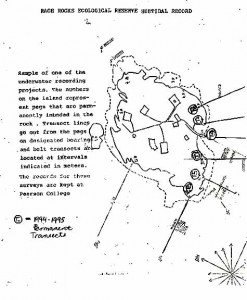 Sample of one of the underwater recording projects. The numbers on the island represent pegs that are permanently imbedded in the rock. Transect lines go out from the pegs on designated bearings and belt transects are located at intervals indicated in meters. The records for these surveys are kept at Pearson College.
Sample of one of the underwater recording projects. The numbers on the island represent pegs that are permanently imbedded in the rock. Transect lines go out from the pegs on designated bearings and belt transects are located at intervals indicated in meters. The records for these surveys are kept at Pearson College.
T = 1994-1995 permanent transects
 There will be other species of algae that we add to our list.
There will be other species of algae that we add to our list.
Sampling
To sample the invertebrates at each of the permanently marked sites we will be using quadrats. Most of you will have done quadrat sampling before.
We will be using a random – sampling method, in which quadrats are placed randomly along / or near the transect line, and the selected invertebrates and algae in each quadrat will be counted. From these data we will calculate the mean (average) abundance as well as the variation in abundance that occurs at each site. These data will plotted in graphs which compare the abundance of each species over time, and with respect to changes in temperature.
We will go over the sampling methods prior to starting the project. Data will be recorded on data sheets pre-printed on underwater paper.
Long-term sampling programmes are often used to follow changes in the abundance of plants and animals over time. We will be looking at changes in the abundance of algae and invertebrates at Race Rocks. These changes will be examined with respect to changes in water temperature. The sampling method we will be using is called a stratified-random sample.
What is stratified random sampling?
In a stratified random sample we will sample the sea floor in a random manner, that is there will be no predetermined pattern to the sampling programme. The samples will be stratified because we will make sure that three depths are represented equally in our random samples.
What will we need?
Each dive pair will need
– a 30m tape measure
– a 0.7m X 0.7m quadrat (0.5m squared)
– a clip board and data sheet (with pencil)
– a slate (with pencil)
– a pair of vernier calipers
– pre-mixed epoxy, and petersen discs
– a set of 20 random number
We have established 6 permanent transects around Race Rocks. Each transect is 30 metres long and runs from the shallow subtidal to about 10m depth. Once a dive pair has located the transect they will be working on, a tape measure will be tied to the shallowest pin (the 0 metre pin) and laid out down to the last pin (30 metre pin).
Before the dive, each dive pair will determine a set of 20 random numbers from a random number table (attached to these pages). There will be two numbers, both between 0 and 9. The first number will refer to the distance along the tape measure, let us say 6.9 metres (it will be the first two numbers, where-ever you start on the table, ie:69). The second number, let us say 7, will refer to the number of flipper kicks right or left of the line. The dive pair will swim along the tape locate the 6.9 mark, then left 7 kicks to the right or left of the 6.9 metre mark. After 7 kicks the diver drops the quadrat and starts to count all the invertebrates and seaweed in the quadrat.
While one diver does the counting and recording, the second diver will measure all of the sea urchins in the quadrat, recording the test diameter of each sea urchin to the nearest cm. Likewise the length of any abalone in the quadrat should also be measured, the abalone should also be tagged, using epoxy and a Petersen disc tag. The tag number should be recorded along with the length of the ablaone. Any abalone you see outside of the quadrat can also be measured and tagged.
Once the quadrat count and the measuring is completed, the dive pair returns to the tape measure, and repeats the process, using the next set of random numbers. In total divers will sample 20 quadrats between 0-10m (10 quadrats on the right side of the line, 10 quadrats on the left side), 20 quadrats between 10-20m and 20 quadrats between the 20-30m, for a total of 60 quadrats per transect. The transects will be sampled twice a year.
Once the dive pair has sampled 20 quadrats from between the 0-10 pins, they move down to the 10-20 metre pins and repeat the process, as time and air supply allow. If it is easier, three dive pairs can work on each transect line, one dive pair working in the 0-10m area, the next pair in the 10-20m area and the third pair in the 20-30m area. Dividing the transect into three areas is the stratified part of the sampling design, using the random number table is the random part of the sampling design.
Back at the College
Wash all the sampling gear you used with fresh water, and return to its appropriate place. Back in the lab you will need to wash the salt off your data sheet, and copy the sea urchin measurements and abalone tag/measurements onto the back of the data sheet for the section of the transect line you and your partner sampled. You will also need to make sure that all of your numbers are readable, and that you have filled in all of the blanks on the data sheet.
During later lab periods you will be entering this data, and calculating the average (mean) density of the animals and seaweed you counted along each transect line. Subsequent years of Pearson College students will continue this sampling programme to generate a long-term view of how invertebrate and algae abundance changes over time.
Insert Random number table and data sheet.
Following is a page of random numbers, you should make sure that you are comfortable using this table. Likewise there is a data sheet, please make sure that you are familiar with the species listed on the data sheet, and that you will be able to identify them underwater.
Random number table — 10,000 random numbers
27791 82504 33523
33147 46058 92388
67243 10545 40269
78176 70368 95523
70199 70547 94331
The first ten numbers in the last line are interpreted as: 7.0 m 1 kick, 9.9 m 7 kicks, 0.5 m 4 kicks, 7.9 m 4 kicks
TABLE B.39 (cont.) TEN THOUSAND RANDOM DIGITS
T = 1994-1995 permanent transects
There will be other species of algae that we add to our list.
Sampling
To sample the invertebrates at each of the permanently marked sites we will be using quadrats. Most of you will have done quadrat sampling before.
We will be using a random – sampling method, in which quadrats are placed randomly along / or near the transect line, and the selected invertebrates and algae in each quadrat will be counted. From these data we will calculate the mean (average) abundance as well as the variation in abundance that occurs at each site. These data will plotted in graphs which compare the abundance of each species over time, and with respect to changes in temperature.
We will go over the sampling methods prior to starting the project. Data will be recorded on data sheets pre-printed on underwater paper. An example of the type of data sheet we will be using is attached.
Jane Watson
Faculty of Science &Technology
900 fifth Street, Nanaimo,
British Columbia, Canada V9R 5S5
Tel (250) 741-2300 – Fox (250) 755-8749 http:llwww.mala.bc.cal
History of The Race Rocks Ecological Reserve
In the fall of 1978, a small group of students of Lester B. Pearson College who were in marine science and diving, together with their teachers, Garry Fletcher and Marks McAvity and with the urging of the light keepers at Race Rocks, Trev and Flo Anderson, set about the task of seeking some form of permanent protection for the underwater and above water ecosystem at Race Rocks. The director of Parks for the Province of British Columbia, Tom Lee recommended that our concerns might be met by seeking Ecological Reserve Status for the area. He gave us the name of Dr. Bristol Foster who was then head of the Ecological Reserve Unit of the Ministry of Lands, Parks and Housing and we invited him to come out to dive with us at Race Rocks. Bristol was as impressed as we were with what he saw underwater and he urged us to set in motion the process that could lead to the creation of a marine ecological reserve for the area. Ecological Reserves had been started in B.C. only a few years earlier. They were created in order to preserve unique or representative ecosystems in the province that could serve for research and education and serve as baselines for monitoring ecological change with the encroachment of humans into natural areas.
Our aim initially was to do as many scuba dives as possible covering the area around Race Rocks and document the life forms there. We also set as a goal the researching of as many aspects of the area as we could. We were able to invite Dr. Paul Breen from the Pacific Biological Station to dive with us and provide a letter of support about the richness of the species diversity at Race Rocks. Our ultimate aim was to host a workshop at Pearson College that would present our information to the B.C. government in order to urge them to get reserve status for the area.
- Larry Bell, Deputy Minister,dives with students at Race Rocks.
- Dr. Hans Roemer and conference group at Race Rocks, 1979.
- Dr.Derrick Ellis speaking to Garry and students Ina and Jens at the workshop session
- Garry and the first tour of Race Rocks by the Friends of Ecological Reserves. About 1983?
- The “Friends” with their spotting scopes.. Hans (PC student from Sweden is guiding them. )
- The students of the Marine Science and Diving class who were instrumental in getting the Ecological Reserve established. Here with Garry Fletcher and Trev and Flo Anderson, spring, 1980.
- Søren Pilgaard Kristensen (PC year 8) installing peg6 for intertidal transects. Søren is now ( 2005) an Associate Professor at the Institute of Geography University of Copenhagen
- Light Keeper Trevor Anderson helping Bobby Villeneuve ( year 8, NWT) install peg 4 for underwater transects
- Marine Science student Marcus Pistor with Robin Baird Installing Hydrophone
- Chris and Lorrie doing intertidal algae herbarium specimens.. marine science class.
- Garry Fletcher just out of the water with hydroid specimens for Anita.
- Dr.Anita Brinckmann-Voss waiting for specimens with our original dive-boat Ubatuba
- Diver Marcel (Belgium) doing a subtidal transect .. 1981.
In February of 1979 a highly successful workshop took place, and the officials invited from the Provincial Museum, the University of Victoria, and the Ministry of Parks were all enthusiastic and supportive of our proposal. (The research presented then is included in the Race Rocks Archives at Pearson College Library, as is other information following the process of creating the reserve and the follow-up involvement of the college since that time.) This link details the program of that workshop. Over the next year we worked at the task of formalizing our proposal, presenting it to cabinet and lobbying to get action. Two students in diving and marine science, Johan Ashuvud from Sweden and Jens Jensen from Denmark were especially relentless in their pursuit of our goal. The proposal had to clear 11 agencies in the government bureaucracy and the cabinet before the Reserve could be proclaimed. These two students invited the Deputy Minister of Parks out to dive and then kept following it up with phone calls, even after hours! Their persistence finally paid off when after a year, the shortest time any reserve proposal has ever taken, the Minister of Parks was able to request Prince Charles on his visit to the college as international board president (April 1980) to make the formal announcement proclaiming Race Rocks the 97th Provincial Ecological Reserve.
The role of the college didn’t cease then. We had volunteered to take an active role in the stewardship of the ecological reserve so in the fall of that year a current meter was obtained from The Institute of Ocean Sciences to obtain data that would form the basis of the Race Passage Tables in the Canadian Tides and Currents Book. Garry Fletcher was appointed the Volunteer Warden of the reserve, to be assisted by the students and staff of Pearson College. Dr. Theo Dombrowski , a faculty member of the English Department at Pearson has also been instrumental in helping the students to further their ecological work on the reserve. We assisted Robin Baird of the Biology Department , Simon Fraser University to install a hydrophone for his research on marine mammals, and we installed baseline transect reference pegs in 14 locations around the main island. We continue to add to our data on intertidal and subtidal transects.
In 1986 we started our association with Dr. Anita Brinkmann-Voss, collecting specimens and providing her with transport to the island for her work on hydroids. Her work has resulted in the identification of over 60 species of hydroid in the reserve and the naming of a new species from the reserve, with others pending further work for possible new species status, along with many new records for North America. To date nine extended essays in Biology or Environmental Systems have been done at Race Rocks by Pearson College students. Over 800 students of Biology, Marine Science or Environmental Systems have done field trips to Race Rocks for the study of intertidal transect technique, tidepool study, or synecological studies. One student also put together a herbarium collection of the marine algae from the reserve. We have been able to conduct guided ecology tours for over 150 grade seven students from the local community each year since the mid nineteen eighties. In the spring of most years we also host a tour of the reserve for the Friends of Ecological Reserves from Victoria. In 1990 we were able to secure an added measure of protection for all ground fish in the reserve by petitioning for and being granted a closure on all commercial fishing and sports fishing except for migratory salmon and Halibut. This was the first such closure of any marine reserve area on this coast that has been granted by federal fisheries.
In the fall of 1992 we assisted the Royal British Columbia Museum in the live production of 24 one hour television shows from the Race Rocks Ecological Reserve. These involved 13 of our divers as well as several faculty for this first Canadian Underwater Safari production. These ecology programs were broadcast live by satellite to down-link sites in Eastern and Western Canada and in the Eastern US. Since that time they have been re -broadcast by cable stations throughout the country. It has been estimated that they have been seen by at least 2 million viewers.
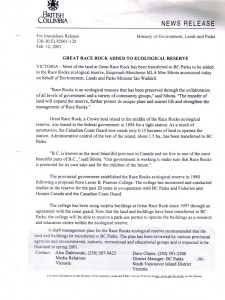 In 2001, Great Race Rocks was added to the Ecological Reserve. Only the envelope of land around the tower was excluded as it was now part of a renewed lease with DFO after they had given up the lease for the entire island.
In 2001, Great Race Rocks was added to the Ecological Reserve. Only the envelope of land around the tower was excluded as it was now part of a renewed lease with DFO after they had given up the lease for the entire island.
See ECOLOGICAL RESERVE REFERENCES
Garry Fletcher, 1996
Lester B. Pearson College
Faculty in Biology, Environmental Systems and SCUBA Diving.
1979 Race Rocks Ecological Reserve Proposal –
1979 Race Rocks Ecological Reserve Proposal –
Abstract:
Lester B. Pearson College
On April 21, 1979, a proposal for an Ecological Reserve at Race Rocks was presented to the Ecological Reserves Branch of the Ministry of the Environment by the students of the diving service and the marine science class at Lester B. Pearson College. The proposal recommended that the reserve should be comprised of the islands and the surrounding subtidal area to a depth of 25 fathoms. The central island, Great Race Rock, could be excluded because of the Coast Guard facilities there, but it was recommended that a request should be made to the Coast Guard to consider its inclusion as well.
–
The proposal outlined the use that has been made of the area in the past, and the present use being made of the area by Pearson College. It was pointed out that the proposal is quite consistent with the purposes of reserves, as stated in the Ecological Reserves Act of British Columbia.
It was emphasized that the uniqueness of the area for its subtidal life and the ever-increasing pressures on the area from divers made the need for protection most urgent.
Included in the report were the results of several investigations on physical and biological conditions carried out by the students. Throughout the report, examples were referred to of how Pearson College might continue to contribute to the reserve in terms of making information available to help in the educational task in reserve maintenance. It was felt that the role of “steward” for the college could be appropriate.
Lester B. Pearson College of the Pacific
R.R. 1, Victoria, British Columbia, Canada V8X 3W9 Telephone (250) 391-2441
College du Pacifique Lester B. Pearson
Route rurale 1, Victoria, Colombie- Britannique, Canada V8X 3W9 telephone (250) 391-2441
-1979Workshop on The Race Rocks Ecological Reserve Proposal
Saturday, April 21.7 1979, 10:30 a.m. at Lester B. Pearson College of the Pacific
Chairman: Garry Fletcher, Marine Science Department
The objective of the workshop is to present and discuss a proposal from the students in the diving service and marine science classes that recommends the establishment of the Race Rocks area as an Ecological Reserve.
Program
10:30 – 12:00 – Presentation of the. proposal by the students of the diving service,
12:00 – 1:00 – Lunch, cafeteria
1:00 – 2:00 – Slide presentation Brent Cooke, Provincial Museum, Victoria
2:00 – 3:30 – A discussion on the unique organisms of Race Rocks and the Ecological Reserve Concept, with the following resource people:
Wayne Campbell, Vertebrate -Zoology, Provincial Museum, Dr. D. Ellis, Biology Department, University of Victoria, Dr. Hans Romer, Ecological Reserves Branch, British Columbia Land Service, Ministry of the Environment
3:30 – 4:00 – Coffee, cafeteria
4:00 – 6:00 – Conclusions and Optional Tour of Race Rocks
CONTENTS PAGE
| Part A | Introduction to the proposal for an Ecological Reserve at Race Rocks | 1 |
| Part B | Delimitation and Description of the Proposed Ecological Reserve | 3 |
| Part C | -The Use Made of Race Rocks by Pearson College in the Past. | 5 |
| Part D | 1978 – 79 Projects at Race Rocks | 6 |
| Birds and Mammals of the Islands | 21 | |
| Species Check-list of Race Rocks | 14 | |
| Bottom Profiles using Sonar | 29 | |
| Physical Factors at Race Rocks | 30 | |
| Part E | The Role of Pearson College in Assisting the Maintenance of an Ecological Reserve. | 34 |
| Part F | Future Projects at Race Rocks. | 35 |
| Part G | Our Concerns for the Future of the Race Rocks Area | 37 |
| References | 38 | |
| Appendix 1 | Letter from Dr. Paul Breen, Pacific Biological Station, Nanaimo | 39 |
| Appendix 2 | Race Rocks Project, October, 1978 | 41 |
| Appendix 3 |
-List of Plates
| 1. | Great Race Rocks as it was in 1970 | i |
| 2. | Gorgonocephalus eucnemis | iv |
| 3. | Epiactus prolifera | 15 |
| 4. | colonia ascidians | 15 |
| 5. | Balanophyllia sp. | 19 |
| 6. | Sponge | 19 |
| 7. | Steller’s Sea Lion | 22 |
| 8. | Killer whale near Race Rocks | 27 |
-LIST OF FIGURES
| Figure | Description | Page |
| 1 | Map of Race Rocks in Relation to Victoria | 3 |
| 2 | Proposed Ecological Reserve: Race Rocks | 4 |
| 3 | Locations of Species Maps | 7 |
| 4 | Key to Species Maps | 8 |
| 5 | Map of Area 1 | 9 |
| 6 | Map of Area 2 | 10 |
| 7 | Map of Area 3 | 11 |
| 8 | Map of Area 4 | 12 |
| 9 | Map of Area 5 | 13 |
| 10 | Individual dive paths | 13a |
| 11 | Checklist of species verified from our Race Rocks Dives | 16 |
| 12 | Vertical Section of one location of Great Race Rock | 20 |
| 13 | Island Numbers for the Location of the Bird Colonies | 23 |
| 14 | Total Number of Breeding Pairs at Race Rocks 1974-1975 | 23 |
| 15 | Race Rocks, July 4th, 1974 No. of Nests | 23 |
| 16 | Race Rocks, July 4th, 1974 No. of Eggs | 24 |
| 17 | Race Rocks, July 14th, 1974 No. of Young | 24 |
| 18 | Race Rocks, July 14th, 1974 No. of Nests | 24 |
| 19 | Race Rocks, July 21st, 1974 No. of | 25 |
| 20 | Distribution of Sea Lions at Race Rocks 1977 | 25 |
| 21a | Rosedale Rock to Lighthouse Depth Sounding (bearing 335 magnetic | 29 |
| 21b | Rosedale Rock towards most easterly island in Race Rocks group depth sounding (bearing of 358 magnetic) | 29 |
| 22 | Map of Sonar Profiles | 28 |
| 23 | Current direction on ebb tide | 31 |
| 24 | Current direction on flood tide | 32 |
| 25 | Temperature graph 1974, 1976 and 1948-57 | 33 |
page 1–
PART A. INTRODUCTION TO THE PROPOSAL FOR AN ECOLOGICAL RESERVE AT RACE ROCKS.
The students and teachers of the marine science and diving classes of Lester B. Pearson College of the Pacific recommend that the Government of British Columbia establish, under the Ecological Reserves Act of 1971, an Ecological Reserve in the area of Race Rocks near Victoria, British Columbia.
To be included in the reserve would be the islands and the surrounding subtidal area to a depth of 25 fathoms. It is appreciated that an exemption may be allowed for the land above the high tide level on the main island , Great Race Rock, as this is presently used as a light station by the Canadian Coast Guard.
This proposal outlines the use that has been made of the area by the college for educational purposes, and the plans for the future educational projects that can be carried out in the area.
The proposal is consistent with several of the purposes as stated in the Ecological Reserves Act.
“…. to reserve Crown land for ecological purposes, including:
- –(a) areas suitable for scientific research and educational purposes associated with studies in productivity and other aspects of the natural environment;
- –(b) areas that are representative examples of natural ecosystems within the province . ….
- –(c) areas that contain unique and rare examples of botanical, zoological or geological phenomena.”
–Part C of this report outlines the use made of Race Rocks by Pearson College marine science and diving students in the past few years. In addition, Part F outlines some of the potential of the area for future ecological studies that are observational in character.
The uniqueness of this area has been documented by Dr. Paul Breen of the Pacific Biological Station in Nanaimo (see appendix 1) and by James M. Goddard in a report to the National Parks Branch in 1975:
“The unique feature at Race Rocks is the subtidal flora and fauna inhabiting the high current velocity channels.” (2)
3 The interest shown by diving photographers recently is also well known. (3) Recently, the National Geographic Society has been in the process of preparing’a feature article on underwater life at Race Rocks; this also attests to the uniqueness of the area. page2 As far as being a representative example of natural ecosystems within the province, the area also has merit. It is moreover one of the high current ecosystem areas that has proximity to a population centre and therefore receives more pressure from the public. –
It is to be hoped that the acceptance of this proposal will enable the preservation of this area for educational and research purposes, as well as for controlled recreational use by the public.
In recent communication with the Coast Guard, evidence has been obtained that could suggest that they would be willing to accept the Ecological Reserve being extended to include the main island, Great Race Rock.
We would highly encourage this, as it would be a more appropriate recognition of the close ecological links of the bird colonies on that island and the rich life in the surrounding area.
- –We have been advised by Mr. Tom Kew, the Regional Manager for Aids and Waterways in the Vancouver office of the Canadian Coast Guard, that the provincial government could send a letter requesting that the main island should be included in the Ecological Reserve.
- –He has indicated that he would see no problem with this as long as it did not interfere with the operation of the light station and foghorn. He suggested that the letter be sent to:
- –Mr. Larry Slaght
- –District Manager
- –Department of Transport
- –1405 Douglas Street
- –Victoria, B.C.
- -V8W 2G3
Hydrophone Cable for Orca Vocalizations
Gordon Odlum and Jean, Lightkeepers -1952 to 1961
Gordon Odlum and his wife Jean were resident at Race Rocks from Oct 1,
1952 – July 31, 1961, So far we have very little information on them
except one special entry in a research paper : The British Columbia Nest Records Scheme Author(s): M. T. Myres, I. McT. Cowan, M. D. F. Udvardy Source: The Condor, Vol. 59, No. 5 (Sep. – Oct.,1957), pp. 308-310 Published by: University of California Press on behalf
of the Cooper Ornithological Society Stable URL: http://www.jstor.org/stable/1364966
I have quoted the part referring to Gordon below: “The purpose of the scheme is to collect information on birds’ nests that ornithologists and bird-watchers find, but which would otherwise go unrecorded or are recorded but left idle in personal field notebooks or diaries. The main items of avian biology that can be analyzed by this scheme are as follows:
1. The timing of the breeding season, the succession of clutches in species which lay more than one, and the variations in laying time from place to place and from year to year.
2. The size of the clutch and how this varies with latitude, altitude and climate.
3. The degree of success that birds have in hatching and rearing their young.
4. The essentials of habitat preference and variation in habitat throughout the range of a
species; these data are provide
In 1956, 1003 cards were returned and these covered 1606 nests or broods.
Particular mention should be made of the 120 nests of Glaucous-winged Gulls (Larus glaucescens) which Mr. Gordon C. Odlum watched on Race Rocks, off the southern
end of Vancouver Island. He was able to study them from the pre-egg stage through to hatching, and his observations are an example of the most valuable types of nest-record returns. It is seldom that sufficient nests are watched right through from the start until they either fail or their young fledge successfully .
SUMMARY A
A Cooperative scheme for the assembling of data on the breeding biology of birds was organized in British Columbia in 1955. The aims of this scheme are outlined, and it is suggested that observers over the whole Pacific coastal region might eventually cooperate in the scheme. Already 1600 cards covering 2700 nests or broods of 139 species have been collected and are available for consultation Department of Zoology, University of
British Columbia, Vancouver, British Columbia, February 8, 1957.
From http://www.lighthousefriends.com/light.asp?ID=1436
Gordon Odlum grew up in Vancouver and during an outing one day he hiked to Point Atkinson Lighthouse, where Keeper Thomas Grafton kindly gave him a tour. Odlum was captivated by the life of a lighthouse keeper, and after frequent visits out to Capilano Lighthouse, he decided to become a keeper himself. After brief assignments at numerous lighthouses, Odlum was transferred to Triple Islands Lighthouse in November 1942. He seemed to made for the work, as a year later, he wrote home, “I think I can truthfully say that I haven’t felt at all lonesome, partly I guess because I’m built this way…”
He must have felt at least a bit lonesome as he decided to bake a tiny loaf of bread and send it to an attractive girl that worked at the Glass Bakery in downtown Vancouver. Not having her home address, he sent the package to the bakery and then eagerly waited a reply. A response arrived in December 1943, a true Christmas gift, and Odlum wasted no time in writing back. “It was sweet of you to remember little old shabby lightkeeping me. It seems such a long time since I had the pleasure of going into Glass Bakery and saying ‘Hello. Two whites please’ to your sunny smile. Fifteen months it has been since I have been ashore. I wonder if you might be married and have four children by now?”
A seven-month-long courtship by mail followed, and the couple married on September 20, 1944 in Vancouver. After a short honeymoon, the Odlums headed north to Triple Islands. While Gordon was gradually introduced to the remote lifestyle of a lightkeeper, eighteen-year-old Jean was plucked from Vancouver and planted on the most remote and confining station in British Columbia. Many a sailor bet the pretty, young girl wouldn’t last a year on “the Rock,” but she did, and it wasn’t until eight years later, in 1952, that the couple was transferred to a station a bit closer to humanity – Race Rocks. After nearly a decade there, Keeper Odlum lucked out and got Point Atkinson, where he was first introduced to lighthouse keeping, and stayed there from 1961-1974.

